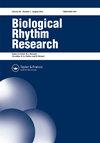褪黑激素在亚剧烈运动中的脂肪燃烧能力
IF 0.9
4区 生物学
Q3 BIOLOGY
引用次数: 1
摘要
在过去的几十年里,运动中葡萄糖和脂质使用平衡的调节越来越受到关注。脂肪和葡萄糖对能量消耗的贡献可以通过激素和其他内源性因素来调节。运动过程中褪黑激素的增加可能与脂质利用率的提高有关,甘油三酯浓度的增加反映了这一点。本研究的目的是探讨白天服用褪黑素对亚最大运动后血糖、甘油三酯和皮质醇反应的影响。八名体育学生被要求在服用褪黑激素(6毫克)或安慰剂50分钟后,以其最大有氧速度的60%跑步45分钟。在运动前和运动后立即测量血浆样品中的皮质醇、甘油三酯和葡萄糖。运动后皮质醇、甘油三酯和葡萄糖水平根据液体变化进行校正。在这两种情况下,运动后皮质醇显著增加(增加≥20%)。只有在安慰剂条件下,运动后血糖水平显著升高。然而,只有在褪黑激素条件下,运动后甘油三酯水平才会显著升高。总之,急性褪黑素给药降低了葡萄糖反应,同时增加了甘油三酯对运动的反应。因此,有可能认为在耐力运动前给予外源性褪黑素可以促进脂肪燃烧。本文章由计算机程序翻译,如有差异,请以英文原文为准。
The fat burning ability of melatonin during submaximal exercise
ABSTRACT The regulation of the balance between glucose and lipid use during exercise has gained increasing attention in the last decades. The contribution of fat and glucose to energy expenditure can be modulated by hormones and other endogenous factors. The increase in melatonin during exercise may be linked to an enhancement in lipid utilization, reflected by an increase in triglyceride concentration. The purpose of this study was to explore the effect of daytime melatonin administration on plasma glucose, triglycerides, and cortisol responses to submaximal exercise. Eight physical education students were asked to run for 45 minutes at 60% of their maximum aerobic speed after 50 minutes of either melatonin-(6 mg) or placebo consumption. Cortisol, triglycerides, and glucose were measured in plasma samples before and immediately after exercise. Post-exercise cortisol, triglycerides, and glucose levels were corrected for fluid shifts. In both conditions , post-exercise cortisol significantly increased (by ≥20%) . Post-exercise glucose levels significantly increased only in the placebo condition . However, post-exercise triglyceride levels significantly increased only in the melatonin condition. To conclude, acute melatonin administration decreases the glucose response while increasing triglycerides’ response to exercise. Therefore, it would be possible to suggest that exogenous melatonin administration before endurance exercise could promote fat burning.
求助全文
通过发布文献求助,成功后即可免费获取论文全文。
去求助
来源期刊

Biological Rhythm Research
生物-生理学
CiteScore
3.00
自引率
9.10%
发文量
34
审稿时长
6-12 weeks
期刊介绍:
The principal aim of Biological Rhythm Research is to cover any aspect of research into the broad topic of biological rhythms. The area covered can range from studies at the genetic or molecular level to those of behavioural or clinical topics. It can also include ultradian, circadian, infradian or annual rhythms. In this way, the Editorial Board tries to stimulate interdisciplinary rhythm research. Such an aim reflects not only the similarity of the methods used in different fields of chronobiology, but also the fact that many influences that exert controlling or masking effects are common. Amongst the controlling factors, attention is paid to the effects of climate change on living organisms. So, papers dealing with biometeorological aspects can also be submitted.
The Journal publishes original scientific research papers, review papers, short notes on research in progress, book reviews and summaries of activities, symposia and congresses of national and international organizations dealing with rhythmic phenomena.
 求助内容:
求助内容: 应助结果提醒方式:
应助结果提醒方式:


